|
North Cascades
Threatened and Endangered Species |

|
THREATENED, ENDANGERED AND CANDIDATE SPECIES WITHIN THE NORTH CASCADES ECOSYSTEM
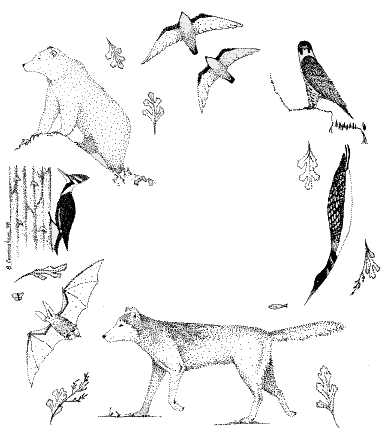
The U.S. Fish and Wildlife Service and the Washington Department of Wildlife list the following mammals and birds of the North Cascades ecosystem as threatened or endangered or consider them to be candidate species:
- American Peregrine Falcon
- Bald Eagle
- Common Loon
- Golden Eagle
- Gray Wolf
- Grizzly Bear
- Harlequin Duck
- Marbled Murrelet
- North American Lynx
- Northern Goshawk
- Northern Spotted Owl
- Pacific Fisher
- Pacific Western "Townsend's" Big-Eared Bat
- Pileated Woodpecker
- Vaux's Swifts
- Western Gray Squirrel

|
American Peregrine Falcon American peregrine falcons have a body length of 16-20 inches and a wingspan of 36-44 inches. Peregrine falcons are strikingly beautiful. Adults have bluish slate gray backs and wings and whitish below with dark barring on the legs and belly. The black feathers of their head and neck form a feather helmet that covers their eyes and cheeks. The peregrine falcons preferred habitat is open country near cliffs. Peregrine falcons prey on other birds and almost always catch their prey in flight. They have tremendous speed during their chase; they fold their wings close to their sides and enter into a dive. The peregrine kills its prey by overtaking it in mid-air and either striking it with fisted feet or grasping it with sharp talons. This diving technique allows the peregrine to reach speeds of up to 200 miles per hour, giving it the reputation of being the world's fastest animal. The introduction of pesticides into the food web was largely, if not exclusively, responsible for the populations of peregrine falcons becoming endangered. Pesticides sprayed on agricultural fields were consumed or absorbed by plant-eating insects. Small birds ate the insects and peregrines ate these birds. The pesticides did not always kill the organisms as it passed through the food chain, but the poisons did build up (concentrate) in the organisms' fatty tissues. Once the peregrine ingested the concentrated pesticides, they caused the shells of the falcons' eggs to form so thin, they would break when the adults attempted incubation. In very recent years, pairs of peregrines have been found breeding on the lowlands near Puget Sound. Bird watchers regularly see peregrines in winter along the Puget Sound coast. Skagit, Padilla, and Samish Bays are examples of areas on the coast where they feed on ducks and shore birds. |
Status in North Cascades ecosystem:
Listings: Federal: endangered | |
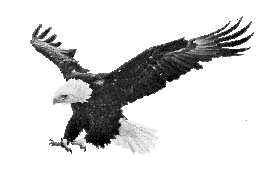
|
Bald Eagle Bald eagles are large raptors; they measure 31-37 inches in height with a wingspan of 70-90 inches. An adult bald eagle will weigh between eight and 12 pounds. Young birds, usually less than 5 years old, are brown or mottled (blotchy brown) all over. Adult birds have dark brown bodies, a yellow beak, with a white head and tail. Bald eagles mate for life and return to the same nesting territory each year. They may use the same nest for several years to raise one or two chicks. Pesticides were largely, if not exclusively, responsible for causing the bald eagle to be federally listed as an endangered species. Chemicals sprayed on agricultural fields washed into the rivers and fish bodies absorbed them. Small vegetation-eating animals consumed remaining chemicals in the fields. These contaminated fish and mammals were eaten by bald eagles. The chemicals did not always kill the organisms as they passed through the food chain, but they did build up in the organism's fatty tissues. Chemicals that were ingested by the bald eagle caused the shells of the bald eagles' eggs to form so thin that they would break when the adults attempted incubation. The population of bald eagles was upgraded to threatened after the restricted use of certain farming chemicals. Concern about the eagle's recovery still lingers, stemming from the loss of habitat to development and the decline of salmon, an important winter food source. |
Status in North Cascades ecosystem:
Listings: Federal: threatened | |
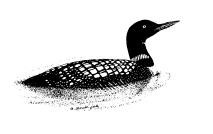
|
Common Loon Common loons can be found only on a few lakes within the North Cascades Ecosystem. They arrive from their winter ocean homes soon after the ice breaks up on the lakes. By the time common loons arrive on the inland lakes, they have changed out of winter dark gray backs and white-bellied attire into the breeding plumage of iridescent dark green heads with white collars, black-and-white backs, and white bellies. Their diet consists mainly of fish, but they will vary it with frogs, reptiles, insects, and aquatic plants. They need a long water runway to become airborne because of their heavy bones and webbed feet, placed far back on their bodies. Once in flight, they travel great distances rather quickly. The disadvantages of heavy bones and rear feet placement become an advantage for diving, in that loons can dive down to 300 feet. The breeding pair selects a grassy bank or floating log extending from shore in which to create a nest, where the female lays eggs that will be tended by both parents. Their eerie, laugh-like call has awakened many a wilderness traveler. They are rather intolerant of human activity. |
Status in North Cascades ecosystem:
Listings: State: candidate | |
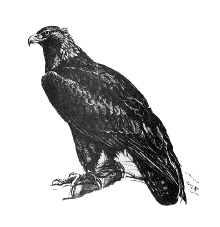
|
Golden Eagle Adult golden eagles have a wingspan of 6-1/2 to 7-1/2 feet, with the female of the species being larger than the male. Mature golden eagles are dark brown with golden feathers on the nape of their necks. The birds' eyes are dark brown and the beaks and feet are black. Immature birds have a broad white tail band followed by a black band on their tails. A pair of golden eagles require a home range of about 35 square miles. The eagles prefer mountainous open country, high meadows above 4,000 feet. They prey upon small mammals, snakes, insects, marmots, and skunks. A pair builds elaborate nests of sticks, twigs, moss, and fur on cliffs or in trees. The pair may alternate use between several nests. Golden eagles mate for life. The female lays one to four eggs. The male helps incubate the eggs, feed, and raise the young. |
Status in North Cascades ecosystem:
Listings: State: candidate | |
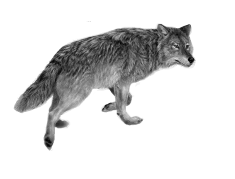
|
Gray Wolf The gray wolf, also known as the timber wolf, is the largest member of the dog family. Gray wolves measure 26-34 inches at the shoulder and are about 6-1/2 feet in length. Adults weigh between 85 and 95 pounds. Their fur colors vary from white to black, although brown, mixed with black, white, and tan is the most common color pattern. Wolves have long legs, large feet, and narrow chests. These adaptations help them to move through snow and thick underbrush. The large feet allow them a greater surface area to walk on in snowy and muddy terrain. Wolves often travel on and along game trails, dirt roads, shorelines, and even highways in the winter to avoid deep snows. Wolves are highly socialized creatures. They live in family groups called packs. A hierarchy exists amongst the pack members; some wolves are leaders and others are followers. A pack can consist of two to 26 individuals, with an average of seven to eight individuals per pack. The size of the pack depends on the quantity and quality of food, water, shelter, and space. The lead, or alpha, male and the lead, or alpha, female wolves mate in the early spring. An average of six pups are born 63 days later. The pups are born blind and helpless, usually in a sheltered place such as a hole, rock crevice, hollow log, or overturned stump. Wolves are carnivores; they feed on large prey such as deer, rather than smaller animals such as rabbits. The teeth of a wolf are designed to tear and cut large chunks of meat and to crush and crack bone. A wolf can consume enormous amounts of food in short periods of time; each wolf is also well adapted to go for long periods of time, even days, without food. As predators, it is usually the young, old, sick, injured, and crippled animals that wolves remove from the surrounding animal populations. The removal of these animals increases the amount of food, space, and cover for the remaining animals. Wolves communicate with each other in a great variety of ways. They position themselves in various poses to indicate aggression or subservience. They whimper, growl, and make other sounds in response to pleasure, fear, or pain. The ears may be erect or flattened against the head and the tail wagged or held stiff depending on the wolf's mood or specific situation. Howling is the most commonly recognized wolf sound. Wolves howl for many reasons like to assemble the pack before and after a hunt, to advertising territory or to identify individuals, and, perhaps, to just howl. |
Status in North Cascades ecosystem:
Listings: Federal: endangered | |
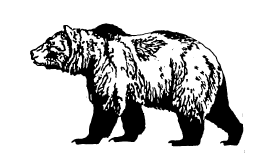
|
Grizzly Bear Grizzly bears are mammals. An adult bear can measure 3-4 feet high at the shoulder and 8 feet tall standing upright. Adults weigh between 250 and 600 pounds. The color of their coat varies from blond to reddish to dark brown. They have a prominent shoulder hump, rounded ears, and claws that measure more than 2 inches in length. Grizzly bears are omnivores. Their diet consists mostly of vegetation -- grasses, roots, nuts, and berries. They also feast on carrion (dead things), insects, fish, and small mammals and have been known to steal kills from other predators. There have always been grizzly bears in the North Cascades Ecosystem, however, many were killed by trappers, miners, and bounty hunters by 1860. The estimated current population of grizzly bears within the entire North Cascades Ecosystem is a maximum of 30-50 bears. Of these, a maximum of 20-30 reside in British Columbia north of Highway 3; Canadian officials do not have an estimate for the number of bears between Highway 3 and the international border. Many factors affect grizzly bear populations: they require a large territory or home range; there is increasingly little protected land available to them; they breed infrequently (once every 3 to 5 years); they have small litters averaging one to two cubs; they spend 2-1/2 to 4-1/2 years raising the cubs, and they are still hunted illegally by humans. Home ranges vary from six to 2,000 square miles, depending on food availability, age, sex, and breeding status of the bear. Home ranges of related females often overlap, and a male's home range generally overlaps with those of several females. Bears utilize the valleys as well as the ridge tops; they travel wherever they need to in order to find enough food, water, shelter, and space to survive. During the cooler months of the year, grizzly bears go into a deep sleep, which many physiologists classify as a highly specialized hibernation. They will use an existing den or cave or will dig a new den. Bears enter their dens as early as the end of October and as late as December. They emerge from their dens between mid March and early April. (Note: Black bears, which are relatively numerous in the North Cascades ecosystem, are relatives of grizzly bears. Black bear are generally smaller than grizzlies. They are to be respected and avoided just like the grizzly.) |
Status in North Cascades ecosystem:
Listings: Federal: threatened | |
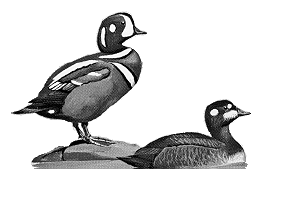
|
Harlequin Duck Harlequin ducks are compact birds; their 1-1/2 pound bodies measure 15-21 inches. They have a wingspan of 24-28 inches. Harlequin ducks are also known as "painted" ducks; they are named after Harlequin clowns. This name may have derived from the colorful markings of the male harlequins; the bluish-gray body is dashed with white and chestnut patches and stripes. Females have brown bodies and three white spots on their head; their coloration helps to camouflage them while they care for the eggs and young. These birds live in and near rough, swift waters. In the winter, they can be found in rocky, sometimes turbulent, coastal waters. During other times of the year, they may be seen in rushing pristine mountain streams. Harlequin ducks feed by day. Their remarkable ability to swim allows them to dive beneath the surface of quick moving water. The ducks use their feet and wings to walk under water along the rocky bottom to feed on, algae, aquatic insects, mollusks, and small fish. To protect themselves from predators at night, harlequins roost on rocks in the middle of quick flowing streams, creeks, and rivers. The female harlequins select a nesting site along a rushing mountain stream. While the males defend the nesting area, females build the grass and feather-lined nest in a tree hole, on a rocky crevice, or under a bush. Once the eggs are laid, the males desert the females and return to the sea. The females will incubate the five to six eggs and lead the young to a secluded part of the river. Often several broods will come together and may be joined by females who were unsuccessful with nesting that year. Once the clutches have fledged, the females and young depart the streams for the sea, where they will spend the winter. When harlequins fly, they keep low and move quickly just above the surface of the water. Perhaps this flight strategy helps to avoid being seen, and subsequently eaten, by predators. "...(T)here is concern that the population of harlequins...may be affected by the cumulative impacts resulting from habitat loss in the upper Skagit and potential future impacts resulting from management decisions and policy regarding resource use" (Christophersen & Kuntz, 1997). |
Status in North Cascades ecosystem:
Listings: Federal and State: species of concern | |

|
Marbled Murrelet Marbled murrelets are small, compact birds about 9-10 inches in length and weighing 7-9 ounces. In the summer, murrelets have dark brown backs and are heavily mottled with brown and white below. The dark backs help to keep murrelets hidden from predators from above searching for prey. During the winter, murrelets live on the ocean. In the summer, they depend on old-growth forests within 50 miles of the coast for nesting sites; murrelets nest on large diameter branches of old-growth conifers. The egg will often be laid in an indentation of moss and lichen that coats a tree branch. Pairs raise one chick each year. Parents travel to and from the ocean to bring food back for the chick. The wings of the murrelets allow them to fly underwater where they capture small fish and crustaceans. Marbled murrelets can be seen on Puget Sound. Very little is known about this bird. |
Status in North Cascades ecosystem:
Listings: Federal: threatened | |
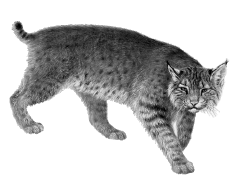
|
North American Lynx Adult North American lynx measure 29-41 inches in length and weigh 11-40 pounds. The tawny brown coat of the lynx is mostly free of spots or barring. The black tipped stubby tail, dark ear tufts, and ruffed cheeks are the most defining characteristics of the lynx. The lynx's coloration helps it to blend into its habitat. This member of the cat family has long fur, long legs and large feet to help it survive in its snowy habitat (Matthews, Dan. Cascade Olympic Natural History. 1988. InterPacific Printing Corporation. p.351). Its furred feet aid the lynx in swimming and help it to move almost silently as it stalks its prey. These cats are mostly active during dusk and dawn; they rest and hide by day in the tree cover. Lynx may rest in trees and pounce on prey from this position. Lynx require dry forests where lodgepole pine is the dominant tree species. These areas are more typical of the east slopes of the Cascades. Lynx depend almost exclusively on snowshoe hare as a prey base, but the cat will prey on other mammals and scrounge carrion. Habitat destruction, trapping, hunting, and reduction of prey base are reasons that have led to the concern about the lynx population. |
Status in North Cascades ecosystem:
Listings: Federal: proposed threatened | |
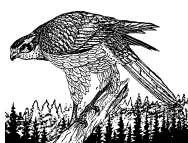
|
Northern Goshawk Adult female northern goshawks are larger than male goshawks. Individuals weigh 1-1/2 to nearly 3 pounds with bodies measuring 19-27 inches long and a wingspan of 40-47 inches. These gray birds have a black crown with mottled white-and-gray bellies. A white line over each orange-red eye is quite distinctive, though difficult to see. This raptor, or bird of prey, prefers to live in remote stands of dense forests. The goshawk's rounded wings and long tail enable it to move gracefully through the forest. It preys upon small mammals, ducks, grouse, quail, small hawks, owls, crows, woodpeckers, and even moths. Goshawks are capable of catching birds in mid-flight as well as on the ground. Both members of the pair may build the nest, but the female is the one who takes charge of incubating the three to four eggs, raising the young, and defending the territory. |
Status in North Cascades ecosystem:
Listings: Federal: species of concern | |
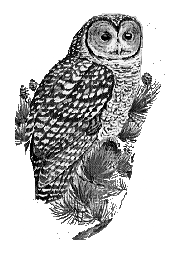
|
Northern Spotted Owl The body of the northern spotted owl measures about 17-1/2 inches. The owl's wingspan reaches 42 inches. Its tan or brown beak is placed in the center of a rounded face, on a tuftless head. Their huge dark eyes help gather light and enables the owls to hunt at night; they are nocturnal creatures. Their name "spotted" derives from the white spots among their brown feathers. The hoot of this owl sounds similar to the bark of a medium-sized dog. The Northern spotted owl has recently come under scrutiny because it requires old-growth forests to survive. This interdependency has made people stop and think about the amount and intensity of logging that is being done in the Pacific Northwest. The presence of the spotted owl in old-growth forests has curtailed the timber harvesting in some of these areas. The spotted owl is part of the old-growth forest food web that includes truffles, flying squirrels, and voles. Truffles are fungi that grow on the roots of old-growth trees and are feasted upon by flying squirrels and red-backed voles. Spotted owls prey upon squirrels and voles. The fungi's root-like system, called mycelium, is far-reaching. This massive network of thread-thin mycelium sheaths the root ends of the tree and thereby helps the tree to capture nutrients by expanding the tree's root system. The squirrel and vole help perpetuate the population of fungi by passing the seeds, called spores, through their digestive systems and excreting them throughout the forest to grow in different locations. The elements of this food web are tied to other parts of different forest cycles. It is a complex system in which all parts are necessary parts. Thus the decline in the population of spotted owls may be an indicator of widespread problems in old-growth habitat. |
Status in North Cascades ecosystem:
Listings: Federal: threatened | |
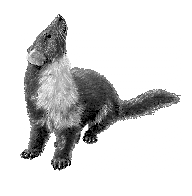
|
Pacific Fisher The Pacific fisher is a member of the weasel family. The fishers have long, thin bodies that measure 31-40 inches in length. Their fur is mostly dark brown. Individuals weigh between three and 18 pounds, with the male being larger than the female. Fishers require a great deal of undisturbed land; they have home ranges of 50-150 square miles depending upon food abundance. "Most records of fisher are in western hemlock, Pacific Silver fir, and Sitka spruce forest zones" (Bob Kuntz, NPS wildlife biologist, personal conversation). They den in hollow trees and rocky crevices. Fishers are mostly nocturnal. The prey upon porcupine and snowshoe hare, although they do eat smaller mammals, fruit, and other plants. The fisher's stomach can soften porcupine quills enough for them to pass through the animal's intestinal tract. (Talk about an adaptation!) "Fishers can rotate their hind feet almost 180 degrees for running down tree trunks. Apparently, they're fast enough to run down and kill martens. The only predators tough enough to overcome fishers rarely consider it worth the fight and aren't fast enough to chase them either" (Matthews, Dan. Cascade Olympic Natural History. 1988. InterPacific Printing Corporation. p.345.) Trapping, timber harvesting activities, and human settlement are thought to be responsible for the reduction in the fisher population. |
Status in North Cascades ecosystem:
Listings: Federal: species of concern | |

|
Pacific Western "Townsend's" Big-Eared Bat The Pacific Western "Townsend's" big-eared bat is approximately 4 inches in length with a wing span of 10-10-1/2 inches, and has, as its name implies, large ears. The fur color of the bat varies, but most often is a slate gray tipped with brown. Adult Townsend's bats weigh between 0.25 and 0.50 ounce! Bats are mammals; they are warm-blooded. Females give birth to live offspring, and subsequently, the young are nourished with their mother's milk. The Townsend's bat is nocturnal and uses its large ears and sensitive echo location to capture and feast on moths, beetles, and flies at night. It lives at elevations ranging from sea level to 3,500 feet and is dependent on cliffs, caves, and old mines for roosting, nursery, and hibernation sites. The bats are highly sensitive to disturbance by people who explore caves or other curious humans and will abandon their roost if repeatedly disturbed. |
Status in North Cascades ecosystem:
Listings: Federal: species of concern | |
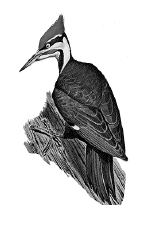
|
Pileated Woodpecker The pileated woodpecker's Latin name translates into "wood cutter" or "tree cleaver." These large, dark woodpeckers are about the size of a crow; they are the largest North American woodpecker. They have characteristic red head crests, white stripes down the sides of the neck, and large white patches on the undersides of the wings. Pileateds prefer to live in mature or nearly mature dense, coniferous forests with large dead trees and snags. They have also been seen in large cottonwood stands along rivers. The pileated's diet consists of mostly insects (they love carpenter ants!), with some consumption of fruit, acorns, nuts, and sap. In the winter, when the ground is snow covered, its diet is mostly dormant ants. Their strong bills are longer than their heads. They use their bills for drumming, accessing food, and excavating. Both the male and female drum, usually on a dead tree, to advertise territory and to attract a mate. Pileateds also drum before going to roost at night. The bill is used to dig for insects in dead, standing trees and logs on the forest floor, to tear apart anthills on the ground, and to strip off the bark of dead trees to get at wood-boring beetles. The bill is also used to excavate roosting and nesting cavities. Wood ducks, flying squirrels, and Douglas squirrels often make their nests in abandoned pileated woodpecker roosting cavities. |
Status in North Cascades ecosystem:
Listings: State: candidate | |

|
Vaux's Swifts Vaux's swifts have tiny 4-1/2 inch bodies. Swifts have long wings that gently curve to a point. They are dark-colored birds, with a shade lighter on the throat and upper breast. As long as the birds are not too high above your head, you may be able to distinguish the slightly forked tail of the black swift from the short, rounded tail of the Vaux's. Swifts have very high metabolisms and often fly several hundred miles a day in search of insects to fuel their bodies. Adult swifts can attain a state of "torpor" when insects are scarce. Young, nest-bound swifts can go into torpor while their parents are away hunting. Torpor "is a condition of deep sleep, with very slow breathing (one per minute) and heartbeat (four to eight per minute) at body temperatures close to the ambient temperature, down to a limit of a few degrees above freezing. Its basic purpose is to conserve calories at times when they are hard to come by" (Matthews, Dan. Cascade Olympic Natural History. 1988. InterPacific Printing Corporation. p.308). Vaux's swifts are closely associated with unmanaged old-growth Douglas-fir forests. The nests of twigs are cemented together with the bird's saliva and built inside the hollows of trees. (Matthews, Dan. Cascade Olympic Natural History. 1988. InterPacific Printing Corporation. p.395). |
Status in North Cascades ecosystem:
Listings: State: candidate | |
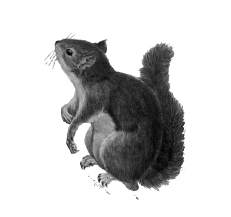
|
Western Gray Squirrel This foot-long mammal has a very bushy tail, which is just a bit shorter than its 10-1/2 inch-long body. As its name implies, the Western gray squirrel has a gray or silvery body with a white belly and reddish ears. Young are born naked, blind, and deaf. They are cared for by their mother. One litter of three to five young are raised each year. Gray squirrels live mainly in drier parts of the Ecosystem because they feed on the nuts of trees that are adapted to that climate; nuts from the ponderosa pine and oaks are among its favorite foods. They also can be seen in the lowlands of the wetter zones feeding on fungi. These mammals are active year round. The gray squirrels build nests of shredded bark and sticks, at least 20 feet above the forest floor. In the winter, the squirrel may move to a hollow tree. The squirrel is hunted by many predators, such as the goshawks. |
Status in North Cascades ecosystem:
Listings: State: threatened | |
| <<< Previous | <<< Contents>>> | Next >>> |
noca/threatened-endangered-species/treas4.htm
Last Updated: 10-Nov-2016